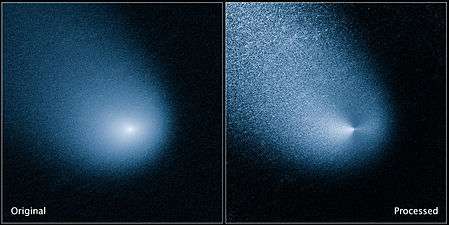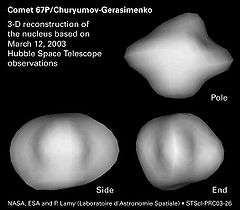Kepler-296e
| Exoplanet | List of exoplanets | |
|---|---|---|
| Parent star | ||
| Star | Kepler-296 | |
| Constellation | Lyra | |
| Right ascension | (α) | 19h 06m 9.60s |
| Declination | (δ) | +49° 26′ 14.37″ |
| Apparent magnitude | (mV) | 15.921 |
| Mass | (m) | 0.380 M☉ |
| Radius | (r) | 0.560 R☉ |
| Temperature | (T) | 4249 K |
| Metallicity | [Fe/H] | +0.168 |
| Physical characteristics | ||
| Radius | (r) | 1.750 R⊕ |
| Temperature | (T) | 267 K (−6 °C; 21 °F) |
| Orbital elements | ||
| Semi-major axis | (a) | 0.17400 AU |
| Orbital period | (P) | 34.14234700 d |
| Inclination | (i) | 89.950° |
| Discovery information | ||
| Discovery date | 2014 | |
| Discoverer(s) | ||
| Discovery method | Transit | |
| Discovery site | Kepler Space Observatory | |
| Discovery status | Published refereed article | |
| Other designations | ||
| KOI-1422.05; K01422.05; 2MASS J19060960+4926143 e; KIC 11497958 e; KOI-1422 e; WISE J190609.59+492614.2 e | ||
| Database references | ||
| Extrasolar Planets Encyclopaedia | data | |
| SIMBAD | data | |
| Exoplanet Archive | data | |
| Open Exoplanet Catalogue | data | |
Kepler-296e (also known by its Kepler Object of Interest designation KOI-1422.05) is a confirmed Earth-sized exoplanet orbiting within the habitable zone of Kepler-296. The planet was discovered by NASA's Kepler spacecraft using the transit method, in which the dimming effect that a planet causes as it crosses in front of its star is measured. NASA announced the discovery of the exoplanet on 26 February 2014.[1]
Confirmed exoplanet
Kepler-296e is a super-Earth with a radius 1.75 times that of Earth. The planet orbits Kepler-296 once every 34.1 days.
Habitability
The planet was announced as being located within the habitable zone of Kepler-296, a region where liquid water could exist on the surface of the planet. It is the second-most Earth-like planet after Kepler-438b, with an ESI of 0.85.[4]
| Notable Exoplanets – Kepler Space Telescope |
|---|

(Kepler-62e, Kepler-62f, Kepler-186f, Kepler-296e, Kepler-296f, Kepler-438b, Kepler-440b, Kepler-442b) (Kepler Space Telescope; 6 January 2015).[5] |
See also
References
- 1 2 Staff (26 February 2014). "715 Newly Verified Planets More Than Triples the Number of Confirmed Kepler Planets". NASA. Retrieved 8 January 2015.
- ↑ Lissauer, Jack J.; et al. (25 February 2014). "Validation of Kepler's Multiple Planet Candidates. II: Refined Statistical Framework and Descriptions of Systems of Special Interest". arXiv:1402.6352
 . Bibcode:2014ApJ...784...44L. doi:10.1088/0004-637X/784/1/44.
. Bibcode:2014ApJ...784...44L. doi:10.1088/0004-637X/784/1/44. - ↑ Rowe, Jason F. "Validation of Kepler's Multiple Planet Candidates. III: Light Curve Analysis & Announcement of Hundreds of New Multi-planet Systems". The Astrophysical Journal. 784 (1): 45. arXiv:1402.6534
 . Bibcode:2014ApJ...784...45R. doi:10.1088/0004-637X/784/1/45.
. Bibcode:2014ApJ...784...45R. doi:10.1088/0004-637X/784/1/45. - ↑ http://phl.upr.edu/projects/habitable-exoplanets-catalog/data
- ↑ Clavin, Whitney; Chou, Felicia; Johnson, Michele (6 January 2015). "NASA's Kepler Marks 1,000th Exoplanet Discovery, Uncovers More Small Worlds in Habitable Zones". NASA. Retrieved 6 January 2015.
External links
| Wikimedia Commons has media related to Kepler Mission. |
- NASA – Kepler Mission.
- NASA – Kepler Discoveries – Summary Table.
- NASA – Kepler-296e at The NASA Exoplanet Archive.
- NASA – Kepler-296e at The Exoplanet Data Explorer.
- NASA – Kepler-296e at The Extrasolar Planets Encyclopaedia.
- Habitable Exolanets Catalog at UPR-Arecibo.
Coordinates: ![]() 19h 06m 9.60s, +49° 26′ 14.37″
19h 06m 9.60s, +49° 26′ 14.37″


